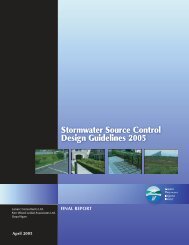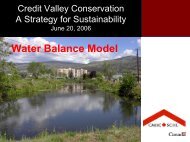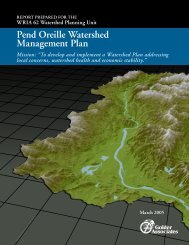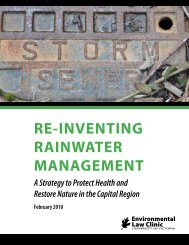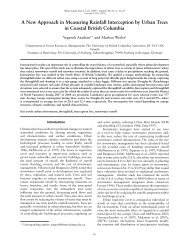1000 Hydraulics Chapter - Ministry of Transportation
1000 Hydraulics Chapter - Ministry of Transportation
1000 Hydraulics Chapter - Ministry of Transportation
Create successful ePaper yourself
Turn your PDF publications into a flip-book with our unique Google optimized e-Paper software.
SUPPLEMENT TO TAC GEOMETRIC DESIGN GUIDE<br />
MoT Section 1010 TAC Section Not Applicable<br />
BC MoT<br />
Where fish and fish habitat are involved, it may be<br />
necessary to design the hydraulic structure to meet the<br />
regulatory agencies approval. The designer will find that<br />
the Department <strong>of</strong> Fisheries and Oceans (DFO), Canada<br />
and the <strong>Ministry</strong> <strong>of</strong> Agriculture, Food & Fisheries<br />
(MAFF) are generally the regulatory agencies.<br />
Table 1010.A - Design Return Periods for Hydraulic Structures (years)<br />
1<br />
2<br />
Road Classification Low Volume Local Collector Arterial Freeway<br />
Hydraulic Structures<br />
Gutters - 5 5 5 5<br />
Stormwater Inlets - 5 5 5 5<br />
Storm Sewers - 10 to 25 10 to 25 10 to 25 10 to 25<br />
Highway Ditches 10 to 25 10 to 25 10 to 25 10 to 25 10 to 25<br />
Culverts < 3 m Span 1 50 to 100 50 to 100 100 100 100<br />
Buried Structures &<br />
Culverts ≥ 3 m Span 2 100 200 200 200 200<br />
Bridges 2 100 200 200 200 200<br />
River Training and<br />
Channel Control Works<br />
100 200 200 200 200<br />
For drainage areas less than 1 ha, the 10-year return period storm can be used.<br />
Design shall be in accordance with BC MoT Bridge Standards and Procedures Manual<br />
1010.03 REQUIREMENTS FOR<br />
DRAINAGE DESIGNS<br />
Land Development Drainage Design<br />
Dual Drainage Concept<br />
All drainage works shall be designed utilizing the dual<br />
drainage or minor/major system concept.<br />
The minor or piped system consists primarily <strong>of</strong> the storm<br />
sewer system comprised <strong>of</strong> inlets, conduits, manholes and<br />
other appurtenances designed to collect and discharge<br />
into a major system for frequently occurring storms (e.g.<br />
less than 5 to 10 year return period).<br />
The major or overland system will come into operation<br />
once the minor system’s capacity is exceeded. Thus, in<br />
developments where the major system has been planned,<br />
the streets and ditches may act as open channels directing<br />
the excess storm water to nearby watercourses without<br />
endangering the public, damaging property or causing<br />
excessive erosion. The major system shall be designed to<br />
convey a 100 year return period peak discharge.<br />
For information on the dual drainage system, refer to:<br />
♦ CSPI Modern Sewer Design (1996), p. 139.<br />
Discharge Rates for Land Development<br />
All drainage systems must include run-<strong>of</strong>f controls to<br />
limit post-development peak discharge rates to the predevelopment<br />
rates for 5 year return period storms.<br />
An additional <strong>Ministry</strong> requirement is an assessment <strong>of</strong><br />
the receiving ditch or watercourse for peak flows greater<br />
than a 5 year return period up to a 100 year return period.<br />
The assessment must document the net change in water<br />
velocity in the ditch or receiving water, identify any<br />
potential impacts from increased peak flows, and make<br />
recommendations for mitigation. In other words, flows<br />
must be managed to ensure that no increase in flooding<br />
and stream erosion occur as a result <strong>of</strong> development storm<br />
drainage.<br />
For information on Storm Drainage Design refer to:<br />
♦<br />
♦<br />
♦<br />
Master Municipal Construction Document (MMCD)<br />
Design Guideline Manual (2005)<br />
Stormwater Planning, A Guidebook for British<br />
Columbia<br />
Water Balance Model for British Columbia<br />
Page 1010-2 June, 2007



